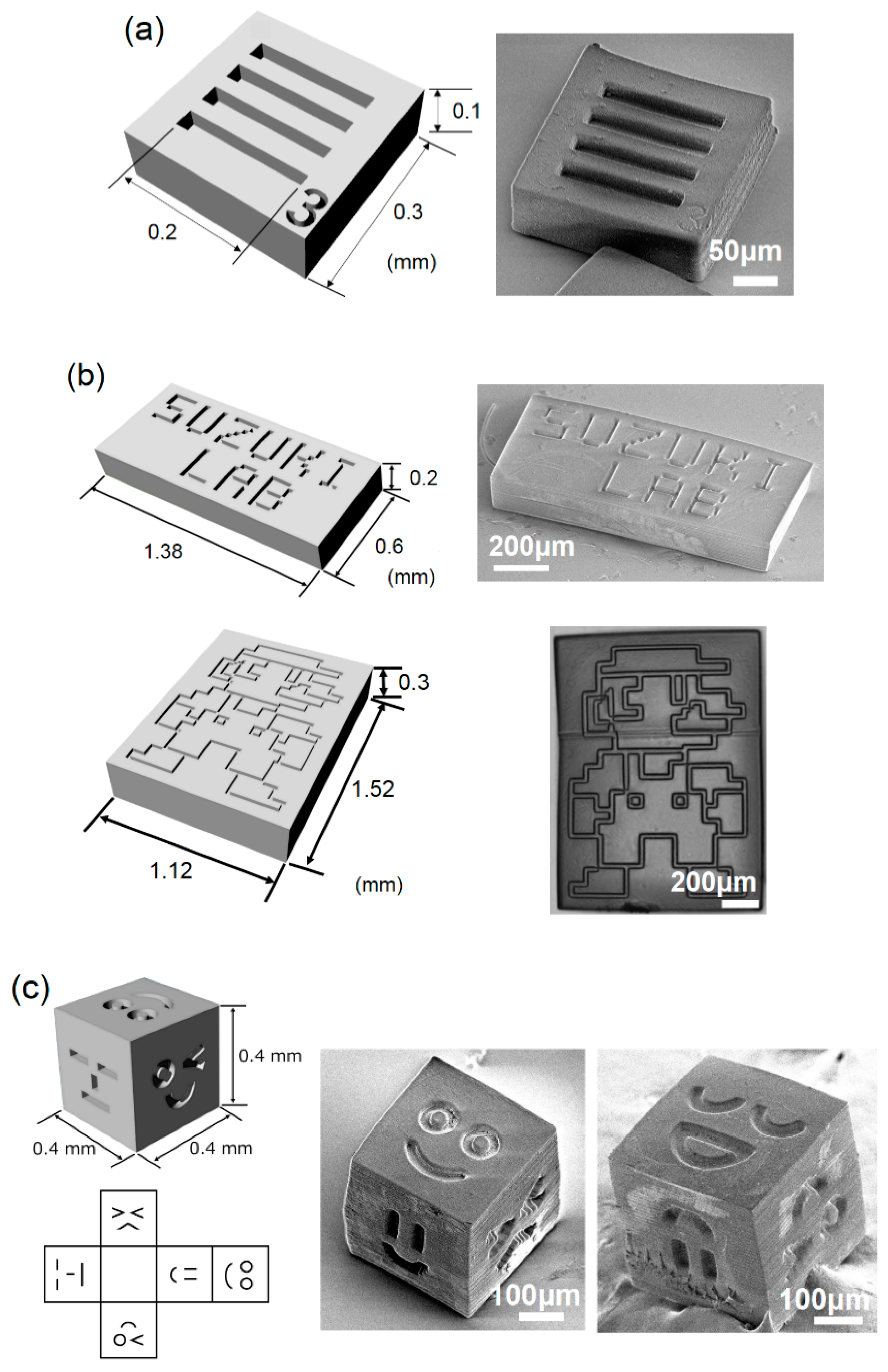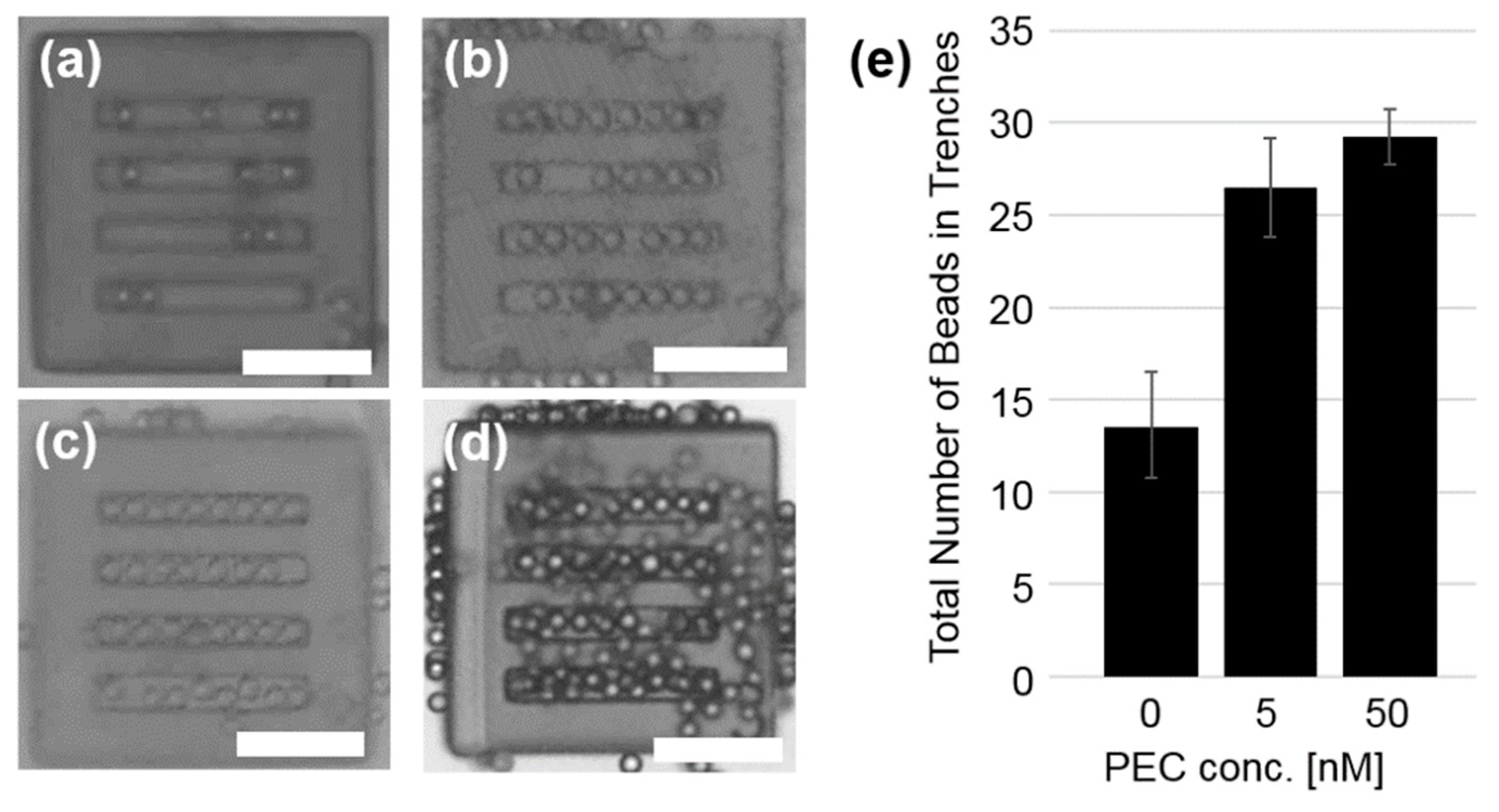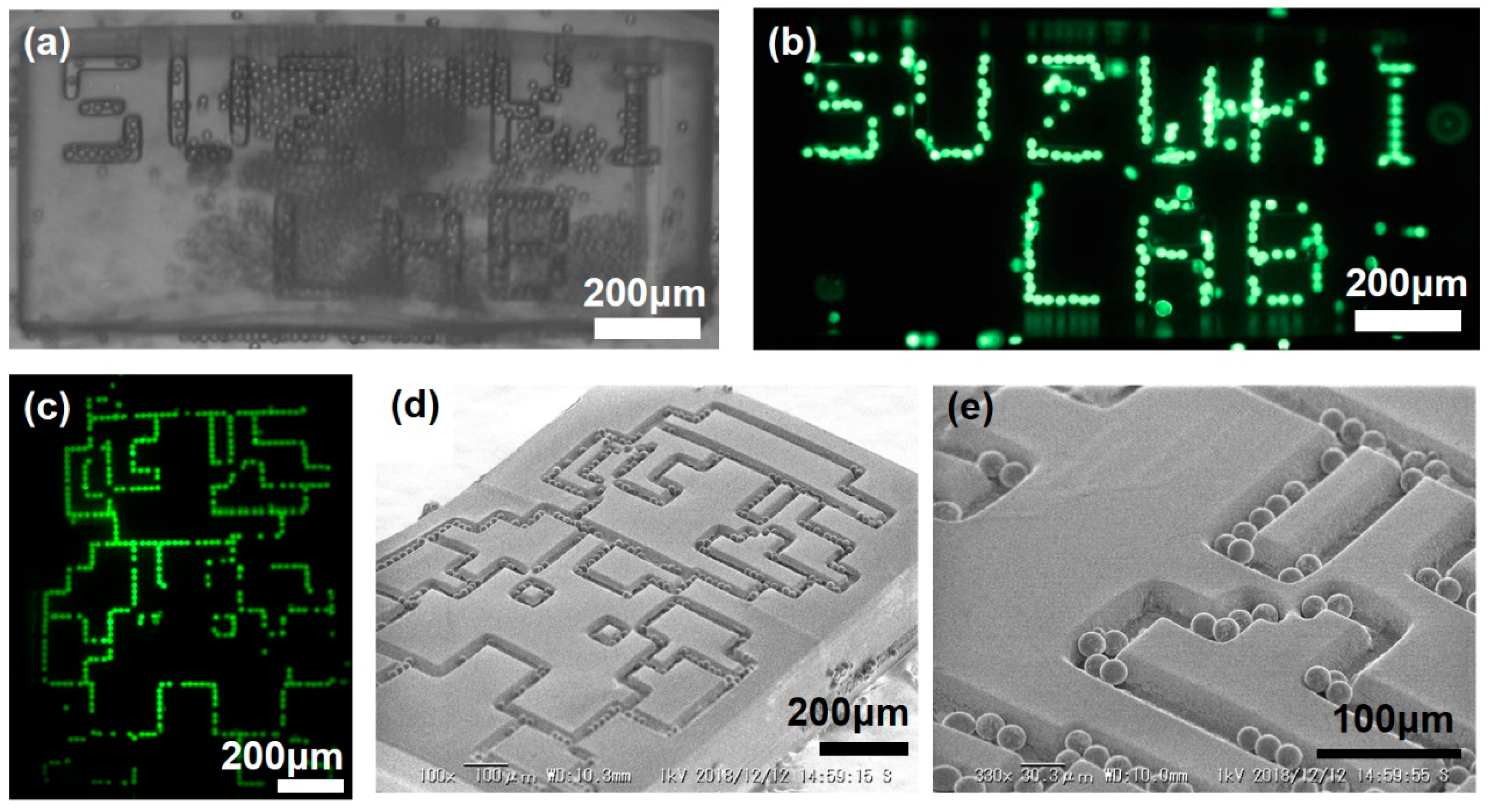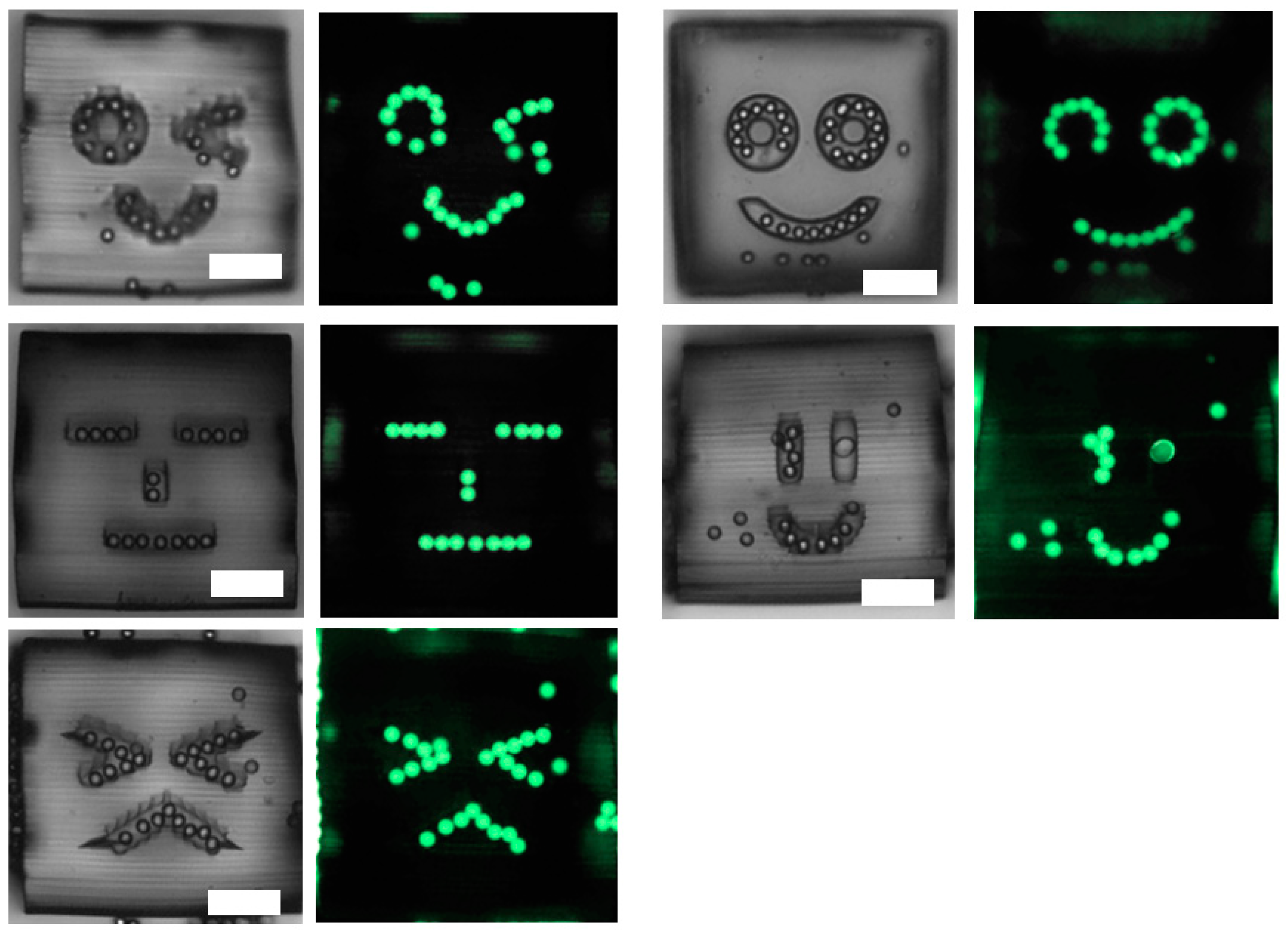Assembly of Microparticles to Patterned Trenches Using the Depletion Volume Effect
Abstract
1. Introduction
2. Principle and Methods
2.1. Principle and Design
2.2. Fabrication and Experimental Procedure
3. Results
3.1. Dependence on the Polymer Concentration
3.2. Assembly of Beads into the Designed Planar Trenches
3.3. Assembly of Beads into the Trenches on 3D Structure
4. Conclusions
Supplementary Materials
Author Contributions
Acknowledgments
Conflicts of Interest
References
- Winkleman, A.; Gates, B.D.; McCarty, L.S.; Whitesides, G.M. Directed self-Assembly of spherical particles on patterned electrodes by an applied electric field. Adv. Mater. 2005, 17, 1507–1511. [Google Scholar] [CrossRef]
- Zhang, J.H.; Yang, B. Patterning Colloidal Crystals and Nanostructure Arrays by Soft Lithography. Adv. Funct. Mater. 2010, 20, 3411–3424. [Google Scholar] [CrossRef]
- Kim, E.; Xia, Y.N.; Whitesides, G.M. Two-And Three-Dimensional crystallization of polymeric microspheres by micromolding in capillaries. Adv. Mater. 1996, 8, 245–247. [Google Scholar] [CrossRef]
- Park, S.H.; Qin, D.; Xia, Y.N. Crystallization of mesoscale particles over large areas. Adv. Mater. 1998, 10, 1028–1032. [Google Scholar] [CrossRef]
- Yang, S.M.; Ozin, G.A. Opal chips: Vectorial growth of colloidal crystal patterns inside silicon wafers. Chem. Commun. 2000, 24, 2507–2508. [Google Scholar] [CrossRef]
- Yin, Y.D.; Xia, Y.N. Self-Assembly of monodispersed spherical colloids into complex aggregates with well-Defined sizes, shapes, and structures. Adv. Mater. 2001, 13, 267–271. [Google Scholar] [CrossRef]
- Yamamoto, M.; Yamada, M.; Nonaka, N.; Fukushima, S.; Yasuda, M.; Seki, M. Patterning Reactive Microdomains inside Polydimethylsiloxane Microchannels by Trapping and Melting Functional Polymer Particles. J. Am. Chem. Soc. 2008, 130, 14044–14045. [Google Scholar] [CrossRef]
- Zhang, J.H.; Li, Y.F.; Zhang, X.M.; Yang, B. Colloidal Self-Assembly Meets Nanofabrication: From Two-Dimensional Colloidal Crystals to Nanostructure Arrays. Adv. Mater. 2010, 22, 4249–4269. [Google Scholar] [CrossRef]
- Hayashi, S.; Kumamoto, Y.; Suzuki, T.; Hirai, T. Imaging by Polystyrene Latex-Particles. J. Colloid Interf. Sci. 1991, 144, 538–547. [Google Scholar] [CrossRef]
- Liu, P.; Bai, L.; Yang, J.; Gu, H.; Zhong, Q.; Xie, Z.; Gu, Z. Self-Assembled colloidal arrays for structural color. Nanoscale Adv. 2019, 1, 1672–1685. [Google Scholar] [CrossRef]
- Yang, S.M.; Jang, S.G.; Choi, D.G.; Kim, S.; Yu, H.K. Nanomachining by colloidal lithography. Small 2006, 2, 458–475. [Google Scholar] [CrossRef] [PubMed]
- Kuo, C.W.; Shiu, J.Y.; Chen, P.L. Size-and shape-Controlled fabrication of large-Area periodic nanopillar arrays. Chem. Mater. 2003, 15, 2917–2920. [Google Scholar] [CrossRef]
- Zeng, Y.; Harrison, D.J. Self-Assembled colloidal arrays as three-Dimensional nanofluidic sieves for separation of biomolecules on microchips. Anal. Chem. 2007, 79, 2289–2295. [Google Scholar] [CrossRef] [PubMed]
- Andersson, H.; Jonsson, C.; Moberg, C.; Stemme, G. Self-Assembled and self-Sorted array of chemically active beads for analytical and biochemical screening. Talanta 2002, 56, 301–308. [Google Scholar] [CrossRef]
- Musevic, I.; Skarabot, M.; Tkalec, U.; Ravnik, M.; Zumer, S. Two-Dimensional nematic colloidal crystals self-Assembled by topological defects. Science 2006, 313, 954–958. [Google Scholar] [CrossRef]
- Wang, X.G.; Miller, D.S.; de Pablo, J.J.; Abbott, N.L. Reversible Switching of Liquid Crystalline Order Permits Synthesis of Homogeneous Populations of Dipolar Patchy Microparticles. Adv. Funct. Mater. 2014, 24, 6219–6226. [Google Scholar] [CrossRef]
- Whitesides, G.M.; Grzybowski, B. Self-assembly at all scales. Science 2002, 295, 2418–2421. [Google Scholar] [CrossRef]
- Syms, R.R.A.; Yeatman, E.M.; Bright, V.M.; Whitesides, G.M. Surface tension-powered self-assembly of micro structures—The state-of-the-art. J. Microelectromech. Syst. 2003, 12, 387–417. [Google Scholar] [CrossRef]
- Boncheva, M.; Whitesides, G.M. Making things by self-assembly. MRS. Bull. 2005, 30, 736–742. [Google Scholar] [CrossRef]
- Crane, N.B.; Onen, O.; Carballo, J.; Ni, Q.; Guldiken, R. Fluidic assembly at the microscale: Progress and prospects. Microfluid. Nanofluid. 2013, 14, 383–419. [Google Scholar] [CrossRef]
- Iyer, A.S.; Paul, K. Self-assembly: A review of scope and applications. IET Nanobiotechnol. 2015, 9, 122–135. [Google Scholar] [CrossRef] [PubMed]
- Israelachvili, J.N. Intermolecular and Surface Forces Preface to the Third Edition, In Intermolecular and Surface Forces, 3rd ed.; Academic Press: Burlington, MA, USA, 2011. [Google Scholar]
- Asakura, S.; Oosawa, F. Interaction between Particles Suspended in Solutions of Macromolecules. J. Polym. Sci. 1958, 33, 183–192. [Google Scholar] [CrossRef]
- Yodh, A.G.; Lin, K.H.; Crocker, J.C.; Dinsmore, A.D.; Verma, R.; Kaplan, P.D. Entropically driven self-assembly and interaction in suspension. Philos. Trans. R. Soc. A 2001, 359, 2629. [Google Scholar] [CrossRef][Green Version]
- Dinsmore, A.D.; Yodh, A.G. Entropic confinement of colloidal spheres in corners on silicon substrates. Langmuir 1999, 15, 314–316. [Google Scholar] [CrossRef]
- Crocker, J.C.; Matteo, J.A.; Dinsmore, A.D.; Yodh, A.G. Entropic attraction and repulsion in binary colloids probed with a line optical tweezer. Phys. Rev. Lett. 1999, 82, 4352–4355. [Google Scholar] [CrossRef]
- Sacanna, S.; Irvine, W.T.M.; Chaikin, P.M.; Pine, D.J. Lock and key colloids. Nature 2010, 464, 575–578. [Google Scholar] [CrossRef] [PubMed]
- Sacanna, S.; Irvine, W.T.M.; Rossi, L.; Pine, D.J. Lock and key colloids through polymerization-induced buckling of monodisperse silicon oil droplets. Soft Matter 2011, 7, 1631–1634. [Google Scholar] [CrossRef]
- Okabe, U.; Okano, T.; Suzuki, H. Self-assembly of artificially manufactured microcomponents using the entropic effect. Sens. Actuators A Phys. 2017, 254, 43–53. [Google Scholar] [CrossRef]
- Kawai, R.; Mori, Y.; Suzuki, H. Polymer-Induced Self-Assembly of a Three-Dimensional Microfabricated Structure. J. Microelectromech. Syst 2019, in press. [Google Scholar] [CrossRef]





© 2019 by the authors. Licensee MDPI, Basel, Switzerland. This article is an open access article distributed under the terms and conditions of the Creative Commons Attribution (CC BY) license (http://creativecommons.org/licenses/by/4.0/).
Share and Cite
Mori, Y.; Kawai, R.; Suzuki, H. Assembly of Microparticles to Patterned Trenches Using the Depletion Volume Effect. Micromachines 2019, 10, 428. https://doi.org/10.3390/mi10070428
Mori Y, Kawai R, Suzuki H. Assembly of Microparticles to Patterned Trenches Using the Depletion Volume Effect. Micromachines. 2019; 10(7):428. https://doi.org/10.3390/mi10070428
Chicago/Turabian StyleMori, Yaoki, Ryota Kawai, and Hiroaki Suzuki. 2019. "Assembly of Microparticles to Patterned Trenches Using the Depletion Volume Effect" Micromachines 10, no. 7: 428. https://doi.org/10.3390/mi10070428
APA StyleMori, Y., Kawai, R., & Suzuki, H. (2019). Assembly of Microparticles to Patterned Trenches Using the Depletion Volume Effect. Micromachines, 10(7), 428. https://doi.org/10.3390/mi10070428





